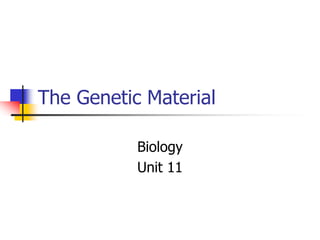
genetic_material-unit111.ppt
- 2. 1. DNA DNA is a Special molecule: 1. DNA stores and carries genetic information from one generation to the next. 2. DNA determines heritable characteristics of organisms. 3. DNA is easily copied since it is replicated during cell division.
- 3. The Structure of DNA: Made of units called nucleotides. Nucleotides include: a. Deoxyribose (a sugar) b. A Phosphate Group c. One of four possible Nitrogenous Bases…
- 4. The Four Nucleotides in DNA 1. Adenine (AD-un- neen) 2. Thymine (THY- meen) 3. Guanine (GWAH- neen) 4. Cytosine (SY-to- zeen) Adenine Guanine Cytosine Thymine Phosphate group Deoxyribose
- 5. Nucleotide Use Like letters in the alphabet, these four nitrogenous bases are strung together in many different arrangements in order to code for and carry genetic information.
- 6. 2. The Structure of DNA The Double Helix: A. “A twisted ladder” forms when adenine and thymine attract to each other. -Cytosine and Guanine attract as well. -So A=T and G=C in a DNA molecule -This attraction (called Base Pairing) is caused by hydrogen bonds between the bases.
- 7. More on the double helix Two separate and opposite strands wrap around each other to form a stable twisting molecule Nucleotide Sugar- phosphate backbone Hydrogen bonds Key Adenine (A) Thymine (T) Cytosine (C) Guanine (G)
- 8. 3. Chromosomes Chromosomes are made of long strands of DNA nucleotides wrapped around histone proteins. 1. The smallest of the 46 human chromosomes contains 30 million (that’s 30,000,000) base pairs. 2. There is 1 meter of DNA in each typical cell nucleus in the human body 3. Tightly wrapped histones and DNA form Chromatin while the cell is in interphase, chromosomes when it is dividing.
- 9. 4. Chromatin generally exists as a long coiled thread, but during mitosis/meiosis it becomes even more coiled, this is what is seen during Prophase through Anaphase and is called a chromosome Chromosome Nucleosome Supercoils Coils Histones DNA double helix
- 10. 4. DNA Replication Before a cell divides, it duplicates its DNA. This process is called replication and it is controlled by a series of enzymes. 1. Each strand of DNA has all the information to create the other strand by “base pairing.” 2. DNA strands are Complementary (or opposites) if the two strands are separated, they can recreate their own complementary strand.
- 12. Process of DNA Replication: 1. Enzymes “unzip” a molecule of DNA by breaking the hydrogen bonds between base pairs. 2. The two strands unwind and each becomes a template for the other strand.
- 13. 3. New nucleotides attach to each of the strands, forming two identical sets of DNA! 4. DNA Polymerase- one of the enzymes involved in replication, adds the new bases (nucleotides) and proof- reads each strand so there are very few mistakes.
- 14. RNA The main role of RNA is to aid in Protein Synthesis RNA is similar to DNA in that both are made of nucleotides
- 15. RNA is different than DNA: Sugar backbone in RNA is Ribose (not Deoxyribose) RNA is single stranded while DNA is double stranded RNA contains Uracil in place of Thymine. (U in place of T) DNA always stays in the nucleus, while RNA can be found in the nucleus and cytoplasm.
- 16. Types of RNA Messenger RNA (mRNA) The role of mRNA is to carry instructions for making proteins from DNA to Ribosomes. Ribosomal RNA (rRNA) One of the building blocks of Ribosomes Transfer RNA (tRNA) Transfers amino acids to ribosomes in the specific order that mRNA states in order to make a specific protein.
- 17. Transcription Transcription is the process of making RNA molecules from DNA molecules. Transcription requires the enzyme RNA Polymerase.
- 18. A Look at Transcription Adenine (DNA and RNA) Cytosine (DNA and RNA) Guanine(DNA and RNA) Thymine (DNA only) Uracil (RNA only)
- 19. The Genetic Code & Protein Synthesis 1. Proteins are made by joining long chains of amino acids together to form polypeptides. a. There are a total of 20 different amino acids. b. Different proteins are made by different combinations and numbers of these amino acids. c. These amino acids are assembled using the Genetic code.
- 20. More on Protein Synthesis RNA contains 4 different bases A, U, C, and G. The order of these subunits is the Genetic code. a. The genetic code is read three letters at a time, this is called a “Codon.” b. Each codon instructs for one amino acid to be built into a chain.
- 21. Example: RNA: UCGCACGGU is read as a series of three codons: UCG-CAC-GGU These different codons represent three different amino acids. UCG CAC GGU Serine - Histadine - Glycine
- 22. The codons for the specific amino acids are listed using this table:
- 23. Translation The process of a cell using mRNA and ribosomes to make proteins is translation
- 24. How translation takes place Protein Chain Ribosome tRNA Amino acid mRNA tRNA ribosome mRNA
- 25. Putting it all together DNA RNA Proteins Traits Transcription Translation •This simple phrase links all the important genetic components together and is the basis for the science of molecular biology
- 26. 6. Mutations Mutations are mistakes cells make when copying DNA. The most common type of mutation is a Point Mutation, this is when one nucleotide is replaced by another. These mutations sometimes alter the RNA molecules transcribed and the proteins translated by the ribosomes. This type of mutation will take place on a piece of DNA that codes for a protein and will be known as a gene mutation
- 27. Chromosomal Mutations Changes in the number or structure of the chromosomes themselves